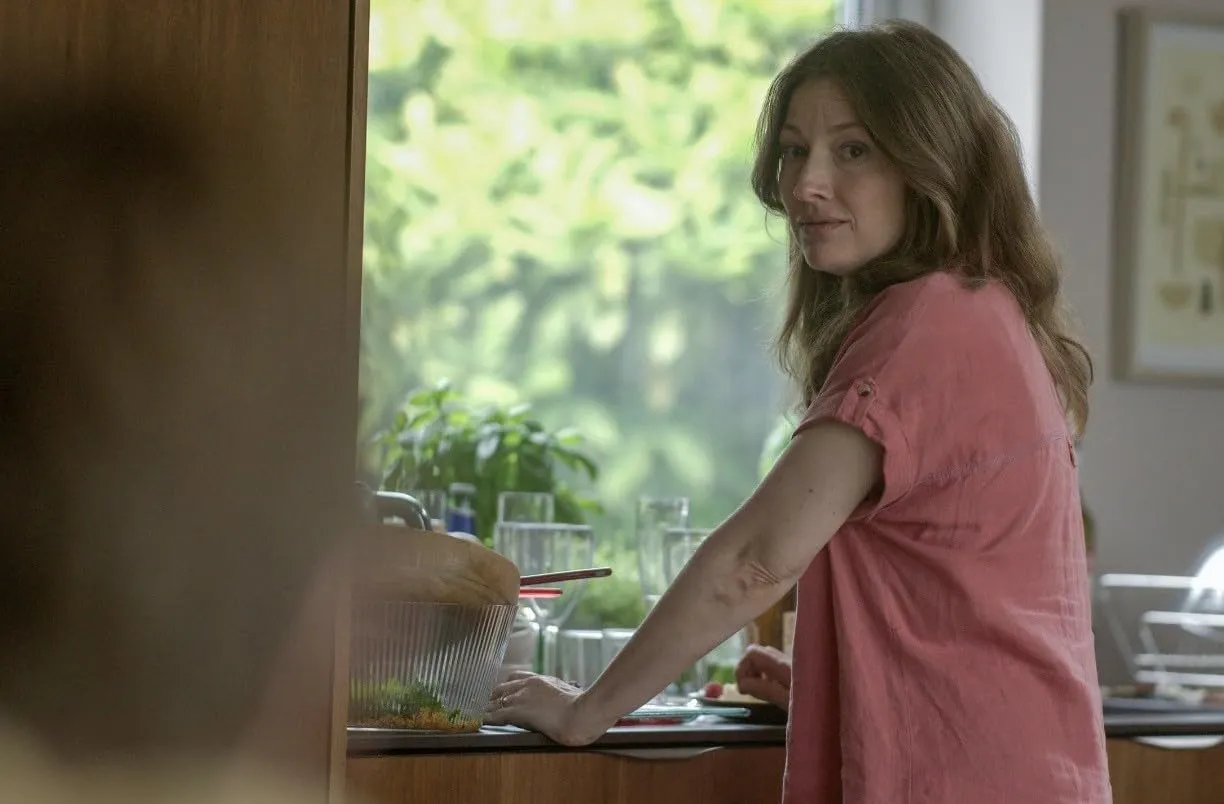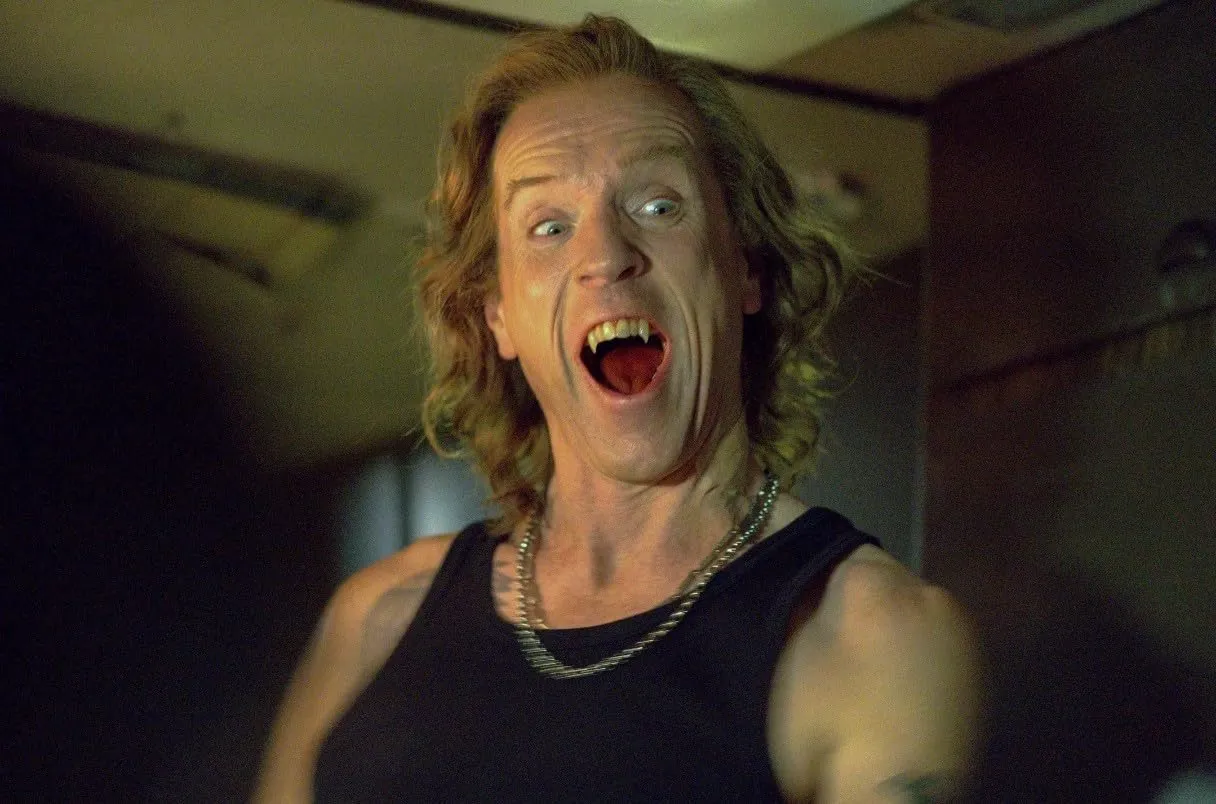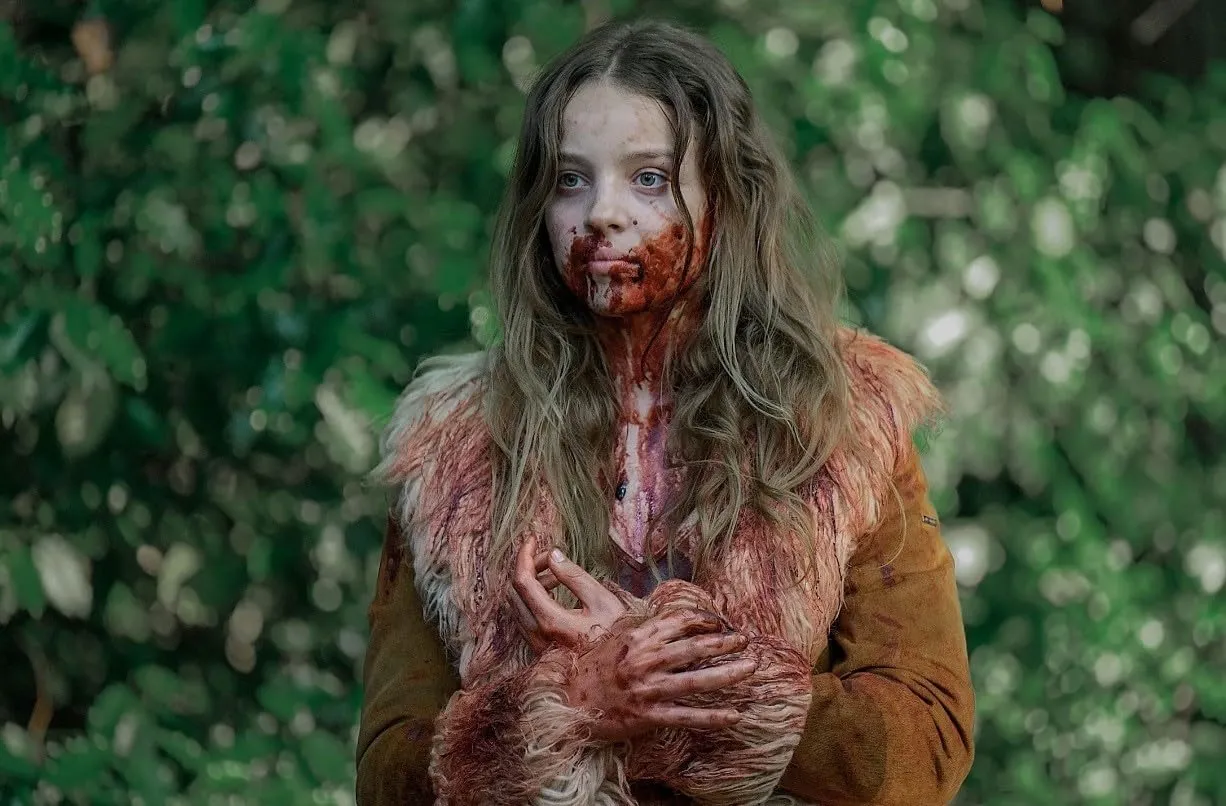Hidden in plain sight, a seemingly ordinary family conceals a thirst for blood. So goes the intriguing premise of The Radleys, a horror comedy based on Matt Haig’s 2010 novel of the same name. Director Euros Lyn adapts the story of a suburban British clan coping with their vampiric nature, spinning gold from the familiar notions of repression, temptation, and inter-generational change.
Peter, Helen, and their children, Rowan and Clara Radley, live as normal neighbors on the surface. But unseen to outsiders, they restrain primal cravings for sustenance and revelry. When Clara’s attack by a classmate forces her first feed and the truth open, chaos blooms. Peter calls his rebellious twin Will for aid, only compounding instability.
As humor and thrills ensue, deeper themes emerge of coming-of-age, addiction, and sexual self-discovery. Clara and Rowan adjust to awakened instincts, battling curiosity and fear. Helen and Peter withstand crumbling routines. The cast brings the makeshift family to a rich life, balancing laughs and hearts. Director Lyn deftly blends scares and satire too, critiquing suburban norms through the lens of “domestic monsters.”
While some criticize scattered focus, The Radleys nevertheless offers a fresh take on a well-worn genre. First-rate performances and an entertaining story reward those embracing Lyn’s imaginative vision of vampiric metaphor and madness thriving in an English community’s cracks.
The Radleys’ Suburban Shroud of Secrecy
Set in the picturesque suburbs of England, The Radleys uses its locations to insinuate a supernatural underbelly of secrets lurking just beneath the glossy veneer. The sleepy community where the Radley family resides seems an unlikely host for mischievous monsters. Nestled among prim houses and neatly manicured lawns, one expects tales of neighbors exchanging tea and gossip, not bloodlust and mayhem.
Yet as the film opens, an unsettled atmosphere prevails. Peering through windows becomes intrigued yet suspicious, as if privy to some uncanny occurrences beyond the curtains. Director Euros Lyn establishes an eerie ambiance, the setting becoming another character shrouded in ambiguity. Are sights and sounds just paranoid imaginings spun from spending too long cooped inside? Or do unnatural tendencies transpire beyond sight, only glimpsed through half-drawn blinds?
Into this environment, the Radley family melts, projecting an image of normalcy. But within their home’s walls exists another world unbeknownst to outsiders. In reality, they struggle against monstrous cravings, restraining primal desires that threaten to emerge should secrecy crack. The true nature they suppress contrasts starkly with superficial appearances.
As the narrative unfolds, setting comes to represent the gulf between what seems and what lies beneath. The Radley’s quest to fit amongst humans despite inhuman biology creates tension. Their battle to maintain the illusion of suburbia symbolizes internal battles to subdue instinct. Ultimately, environment reflects the dichotomy of natural versus unnatural, real versus performed, and keeps viewers guessing what might seep through the cracks.
Bringing The Radleys’ Undead Ensemble to Life
At its core, The Radleys succeeds due to the incredible performances anchoring its imaginative premise. Chief among these are Damian Lewis, navigating a tour de force dual role with aplomb.
As reserved father Peter and unhinged Uncle Will, Lewis imbues both with distinct identities through nuanced mannerisms and delivery. Switching seamlessly between the restrained and unbridled, he leaves no doubt of their fraternal connection while forging divergent onscreen impacts.
Equally impressive is Kelly Macdonald’s embodiment of stressed mother Helen. Burdened by years concealing primal urges, Macdonald breathes heartbreaking layers into each anxious tic and hurried motion. Her attempts at masking internal turmoil opposite Lewis’ provocations drive compelling will-they/won’t-they tension until dramatic conclusions.
As the younger generation discovers monstrous truths, Bo Bragason and Harry Baxendale imbue the teens with authentic quandaries. Bragason finely balances Clara’s violent awakening with nascent confidence, while Baxendale shades Rowan’s changes with awkward earnestness befitting formative experiences. Their stories resonate through relatable challenges, a credit to nuanced portrayals.
Supporting the leads, Shaun Parkes infuses neighbor Jared with a pitch-perfect paranoid fervor, offsetting his dark undercurrents with moments reminding suspicion stems from trauma. Appearing to simply coexist yet guarding motives, Parkes amplifies surrounding unease.
Together, the cast breathes profoundly human qualities into otherworldly characters, forging empathy for surreal struggles. Where the story sometimes loses focus, their embodied connections consistently captivate. Even the humans engage, never missing chances to enrich multilayered relationships driving this ensemble’s community of undead outsiders and those wary of their nature. Performance is what lingers, long after final frames fade.
While missed opportunities with Clara’s story remain lamentable, the entire cast sparkles in assigned material. Their nuanced work elevates Lyn’s vision from page to screen, infusing lively subscribers to a timeless mythos with pulses, passions, and painfully mundane challenges we all face, supernatural or not. It is, as often said, performance that makes the project, and in The Radleys, performance is everything.
Inner Battles and Bloodlust: Thematic Undertones of The Radleys
Beneath its comedic hijinks and creature feature antics, deeper themes play out in The Radleys involving perpetual struggles all can relate to. Clara and Rowan navigate churning changes as teenagers do, from difficult choices to emerging passions. Their coming-of-age challenges take on monstrous dimensions yet mirror everyday issues.
Helen too faces familiar trials, warring with addiction’s siren call. Abstaining from primordial instincts tests willpower, like resisting any vice. For the Radleys, vampirism represents addiction in its many forms—behaviors easily justified yet poisoning life when indulged. Lyn transforms Haig’s metaphor to scrutinize humanity.
Rowan additionally explores his awakening sexuality and confusing feelings for Evan. Navigating new relationships challenges even ordinary adolescents, let alone beings cursed with predatory hungers. For Rowan, suppressed cravings parallel repressed teenage desires, both bubbling forth as adolescence opens doors previously shut.
Through the Radleys’ monster metaphor, Lyn probes universal anxieties around transformation, temptations, and fitting in. Cutting to core struggles, his nuanced themes resonate beyond formulaic horror conventions. Clara and Rowan’s very real encounters mirror our own, imbuing otherworldly struggles with profound humanity even non-movie monsters arguably face.
The film dissects what it means to finally understand oneself and one’s needs, despite societal or genetic barriers. Its characters find inner strength battling wolves within woodland cottages’ walls as much as any do wrestling private demons suburbside. Ultimately, The Radleys transforms vampiric metaphor into a prism reflecting life’s most persistent battles and victories.
Finding Balance in The Radleys’ Tonal Juggling Act
Euros Lyn navigates a tricky tightrope with The Radleys, blending laughs and scares into a surprisingly cohesive blend. The director plays with fire at times, crafting moments that could tip too far toward either terror or parody if mishandled. Yet through sharp writing and assured handling, Lyn finds Goldilocksian balance.
Pulling from Matt Haig’s young adult novel, the adapted screenplay injects sly social satire into suburban trappings and norm conventions. Good-natured mockery of curtain-twitching neighbors and veneers of respectability lend lightheartedness despite grim underbellies.
Though straddling horror and comedy genres, Lyn sustains an electric current of fright throughout. Subtle unease lingers in every scene, awaiting someone or something to snap, intensifying comedy’s bite. Even silly plot twists land with impact due to the impeccable pacing of tension’s rollercoaster ups and downs.
Migrating source material’s intended younger audience target was a bold choice, but Lyn instills sufficient gravitas when gravitas is due. Scenes handle more mature topics like Rowan’s sexuality and repressed desires deftly despite darker humor infusions. Under the director’s deft hand, moments hit needed notes of humanity.
While some criticize scattered focus hurting plot cohesion at times, Lyn’s tonal juggling proves The Radleys is greater than the sum of any single part. Threading genuine fright, satire, and heart, the director taps layered themes and the breadth of vampire lore with panache through a refreshingly British lens. For fans craving new spins on familiar monsters, the risks pay off in spades.
Weaving Too Many Threads in The Radleys
Juggling an ensemble and various storylines proves a mixed bag for The Radleys. Euros Lyn’s film introduces an engaging premise exploring a vampire family but spreads focus too thin. Subplots and characters proliferate, yet none emerge as the definitive highlight.
Clara’s harrowing origins driving the plot early on seem primed for rich exploration. However, her story becomes sidelined for lesser threads. Rowan assumes the mantle instead, though his coming-of-age offers less intrigue than his sister’s violent awakening hinted at more carnage to come.
Spreading screentime thinly prevents any narrative line from blossoming fully. Tension remains as vampiric familial chaos unfolds, yet certain scenes feel like wasted chances for character diving. Pacing suffers in a bloated third act attempting resolution, momentum lost.
Not all is lost; the cast remains a beacon. Entertaining performances elevate even scattered scenes. Particularly fine are Damian Lewis and Kelly Macdonald bringing humanity to monstrous struggle amid tensions brewing. Their ties anchor whenever subplots stray.
While critique exists, Lyn presents an offbeat vision altogether commendable. The Radleys spotlights a captivating premise, however diluted in execution. With tightened focus on its most compelling components—like the complex women at its heart—this peculiar tale of suburban monsters may have shone even brighter.
Bringing Light to The Radleys’ Shadowy Edges
Fittingly for a film dwelling in twilight territories, The Radleys navigates some murky terrain in its storytelling. Juggling characters and subplots leaves certain corners of Lyn’s vampire twist unevenly illuminated. Yet underneath scattered narrative seams glimmer seeds of something rather peculiar and charming.
Familiar fans sink into refreshed British soil here, revitalizing worn archetypes with a cheeky wit. Wry social satire and lively performances enliven well-worn genre mechanics. Meanwhile, layered metaphors resonate beneath the mayhem, exploring perpetual human struggles with nuance.
Despite some expansive elements crying out for tighter focus, the heart of this supposed’monster’ family remains cogently intact. Their dynamic glows radiantly due to committed casts’ guidance. Such victories overwhelm minor shortcomings, fostering fondness for Lyn’s dark debut.
Ultimately, The Radleys proves a refreshingly quirky nightmare nestled in suburbia’s veneer. Far from a breakout hit, its merits lie in honoring tradition with playful panache. Fans cheering fresh supernatural twists on recognizable struggles need venture no further than this offbeat oddity’s shores to find welcomed diversion.
The Review
The Radleys
The Radleys sink fangs into the vampire mythos with amusing panache. Lyn's offbeat spin glistens with wit and resonant themes, anchored by outstanding performances that breathe heart into its eclectic brood of "domestic monsters." Familiar fangs find new life in this flavorful British black comedy.
PROS
- Fresh take on vampire lore with intriguing family dynamics and themes
- Sharp humor and social satire skewering suburban norms
- Terrific lead performances strongly carrying narrative
- Sustained tension and menace alongside comedy
CONS
- The story loses focus by including too many subplots and characters.
- Pacing drags in an overly long third act.
- Wasted potential in developing certain storylines like Clara's





















































